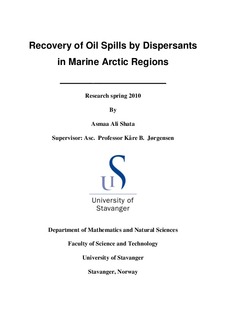| dc.contributor.author | Shata, Asmaa Ali Mahmoud | |
| dc.date.accessioned | 2010-07-07T13:54:13Z | |
| dc.date.available | 2010-07-07T13:54:13Z | |
| dc.date.issued | 2010 | |
| dc.identifier.uri | http://hdl.handle.net/11250/182414 | |
| dc.description | Master's thesis in Environmental technology : offshore engineering | en_US |
| dc.description.abstract | The initial appearance of dispersants was 1960s and 1970s; oil spill dispersants have been the topic of significant research, testing, and debate. In spite of published reports about dispersant toxicity and effectiveness vary greatly, most spill response experts agree that oil spill dispersants are a valuable tool for responding to marine oil spills.
Dispersants are oil spill response chemicals that are used to disperse floating oil into the water column. Dispersant cause a temporary increase in the concentration of oil in the water column, but do not add to the inherent toxicity of oil. Dispersants are effective in getting more oil into the water column compared to the amount that enters in the absence of dispersants, but the inherent toxicity of the oil remains the same whether physically or chemically dispersed. By increasing the surface area of oil, dispersants can facilitate biodegradation of oil. Effective of dispersants during the early phases of oil spill response may prevent or reduce impacts to coastal habitats and wildlife. This means that it is important to be prepared before the situation arises. Personnel should be well trained and needed equipment easily available. A pre-made priority list of different geographical areas to protect is a vital tool to make the correct decisions when concentrating the effort. The net environmental benefit of dispersant use need to be weighed against other oil spill response options. Decision makers must consider the potential effectiveness of dispersant treatment as well as the potential for environmental benefits or harm. When dispersant technology progresses, the policy debates among responders, regulatory agencies, researchers, and environmentalists continue to try to define optimal dispersant application conditions while ensuring that this response tool does not aggravate the environmental damage caused by marine oil spills. | en_US |
| dc.language.iso | eng | en_US |
| dc.publisher | University of Stavanger, Norway | en_US |
| dc.relation.ispartofseries | Masteroppgave/UIS-TN-IMN/2010; | |
| dc.subject | teknisk miljøvern | en_US |
| dc.subject | offshore teknologi | en_US |
| dc.title | Recovery of oil spills by dispersants in marine arctic regions | en_US |
| dc.type | Master thesis | en_US |
| dc.subject.nsi | VDP::Technology: 500::Environmental engineering: 610 | en_US |
